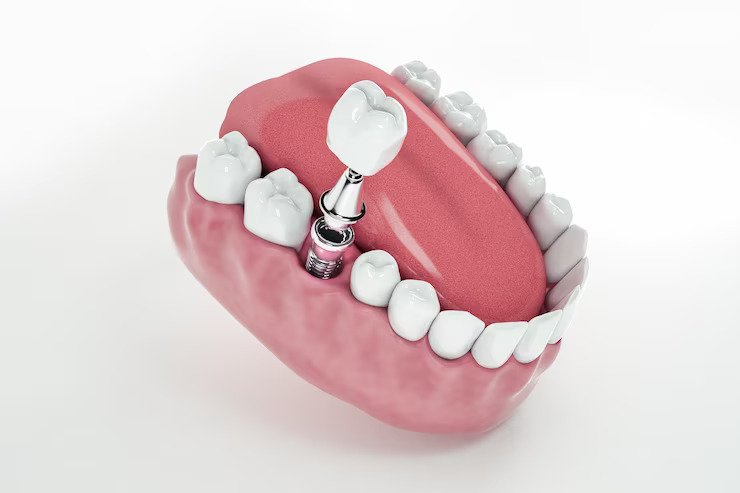The Art Of Dental Implants: A Comprehensive Guide For Potential Patients
There’s an old saying, “Smile, it’s free therapy.” But what if you’re reluctant to smile due to missing teeth?
Thankfully, modern dentistry has a robust solution: dental implants. This comprehensive guide is all about exploring the art of dental implants, providing essential knowledge for anyone considering this procedure.
Tooth loss is an uncomfortable as well as distressing event for a lot of people. But with the advancement of science and modern technology, there is absolutely nothing to worry about.
Understanding Dental Implants: The Basics
Before diving into the specifics, let’s clarify what dental implants are.
A dental implant refers to a medical device used to replace an absent tooth. The implant is nothing but a tiny titanium screw inserted into the jawbone, which works as a feigned tooth root. An abutment then remains attached to the implant, and a prosthetic tooth (crown) is fixed onto the abutment, creating a natural-looking artificial tooth.
If you’re considering dental implants in Wichita, KS, Farmer & Williamson offers excellent dental care providers skilled in this advanced procedure. This comprehensive guide consists of details about dental implants detail, such as their benefits and the associated risks. So, make sure you keep reading till the end.
Why Choose Dental Implants?

The benefits of dental implants go beyond aesthetics. They provide a sturdy, long-lasting solution for teeth that goes missing, improving overall oral health. Let’s examine the advantages more closely:
Preserve Facial Structure
When you lose a tooth, the surrounding bone begins to shrink. Dental implants stimulate the bone, much like natural roots, thus preserving the jawbone and maintaining facial structure. They are an infamous method for preserving and protecting natural tooth tissue by preventing the requirement to remove adjacent teeth.
By reducing bone resorption as well as deterioration, these also preserve teeth that lead to a loss of the height of the jawbone. Moreover, dental implants enable jawbone structure restoration as they reduce the stress on the rest of the oral structures and keep the natural tooth tissue preserved.
Improve Oral Function
Missing teeth can make it difficult to eat certain foods. With dental implants, you can enjoy your favorite meals without worry. Since dental implants are nothing different from your natural teeth, there is absolutely nothing to worry about. As time passes by, they will enable jaw bone preservation. This significantly lessens bone resorption.
Replacing natural teeth with implants lets you chew your food in a better way so that you can carry your oral functions in a smooth way.
Enhance Speech
A missing tooth can affect your entire speech. Dental implants denote a possible solution that lets you speak clearly. Thus, you don’t have to worry about stopping your sentence in the middle of your conversation just because of a troubled tooth. By putting an end to your teeth gaps, dental implants enhance your speech.
Words that are slurring and complex to pronounce are a big negative impact on tooth loss. But when you have a teeth implant, there is absolutely nothing to scratch your head about. An absent tooth might also lead to poor nutrition, which ultimately boosts the risk of inhibiting gum infections.
Long-term Solution
While the initial cost can be higher than other tooth replacement alternatives, dental implants might last a lifetime with proper care, making them a cost-effective solution in the long run. Also, a well-cared and strategized dental implant usually offers a great survival rate as compared to other teeth replacements.
Since the implant technique and technology are improving, so should the rate of their success. Those who have good health have a better chance of successful implants.
The Dental Implant Process: A Step-by-step Guide

The procedure for a dental implant may seem complex, but don’t let it deter you.
Let’s break it down step-by-step:
- Consultation and Planning: The journey starts with a thorough examination, including X-rays or CT scans, and a detailed discussion with your dentist or oral surgeon about your medical history and expectations.
- Bone Grafting (If Needed): If you have a jawbone that isn’t very thick or extremely soft, you might require bone grafting. The bone graft creates a greater solid base for your implant.
- Implant Placement: The dental implant is put into the jawbone beneath the gum line through a surgical procedure.
- Osseointegration (Healing): A healing period is necessary for the implant to mix with the entire bone, a process known as osseointegration. This can take several weeks to months.
- Abutment Placement: After the healing is complete, the dentist places an abutment, which serves as the connector between the implant as well as the crown.
- Crown Placement: Finally, the dentist attaches the prosthetic (crown) tooth to the abutment, resulting in your new smile.
Post-procedure Care and Maintenance
Caring for a tooth implant refers to as caring and straightforward as your usual teeth. Continuous brushing, routine dental check-ups, and flossing are crucial for maintaining the health and longevity of the implant. Place gentle pressure on your jaws, chin, and cheeks with the help of a cool pack.
In case of a removable denture, place a gauze in your molar area and bite downwards. Leave the gauze in the same position if you experience no active bleeding. Make sure you lie in a semi-reclined posture by keeping your head off unless you start feeling dizzy. Finally, rinse your mouth for 2 weeks straight as prescribed by the dentist.
Conclusion
Dental implants refer to a powerful solution for tooth loss, offering a fusion of function and aesthetics that can significantly enhance the quality of life. Understanding the art of dental implants is the first step toward regaining a healthy, confident smile. As always, consult with your dentist or oral surgeon to determine the best course of action for your unique situation.
Read Also:
- 7 Signs You Need Dental Implants
- Important Dental Habits To Teach Your Children
- Benefits Of Working With A Dental Staffing Company



